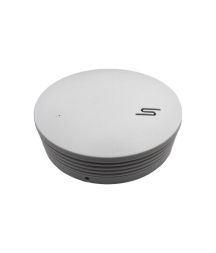Smoke detectors
Smoke detectors are installed to prevent major fires indoors by detecting early signs of smoke or fire. Once a potential hazard is sensed, they emit a loud alarm, typically around 86 dB, and light up, ensuring that nearby people quickly notice the warning. In some systems, they may also alert emergency services or building managers directly.
Types of Smoke Detectors
- Photoelectric Detectors: These detectors consist of a photodiode and an LED. Under normal conditions, the LED’s light is detected by the photodiode. When smoke enters the device, it disrupts the light, triggering the alarm.
- Heat Detectors: Equipped with a thermal sensor, these detectors monitor room temperature. If the temperature rises by more than 5 degrees Celsius per minute, the alarm is activated.
- Multi-Sensor Detectors: The most advanced type, these detectors only sound an alarm when the temperature rapidly increases, and both smoke and open flames are detected simultaneously. This selective sensitivity reduces false alarms, ensuring emergency services are only alerted when necessary.
Design and Functionality
Most smoke detectors have a circular casing. Inside, a circuit board manages the device's functions. Detectors can run independently on a 9V alkaline battery or connect to a 220V power source. Installation should be handled by an electrician or certified technician.
Key Features
Made from durable plastic, smoke detectors can withstand temperatures ranging from -40 to +122°F. They are impact-resistant, maintain their appearance despite sun exposure, and are shielded from dust, allowing reliable smoke detection.
Installation Tips
Smoke detectors should be mounted on the ceiling, at least 30 cm from any corner, as smoke tends to rise. A photoelectric detector is unsuitable for steam-heavy areas like saunas, where it may mistakenly respond to steam as smoke. For gas stations or storage areas with gasoline, a heat detector is more reliable, as gasoline fires produce minimal smoke.
In rooms with flammable materials, place detectors close to ventilation outlets to catch early signs of fire.
To turn off the device, press the designated button on the casing or disconnect it from the power source. After a brief pause, usually 10 minutes, the detector can be reactivated.
In residential spaces, up to 12 smoke detectors can be linked in a network.





























